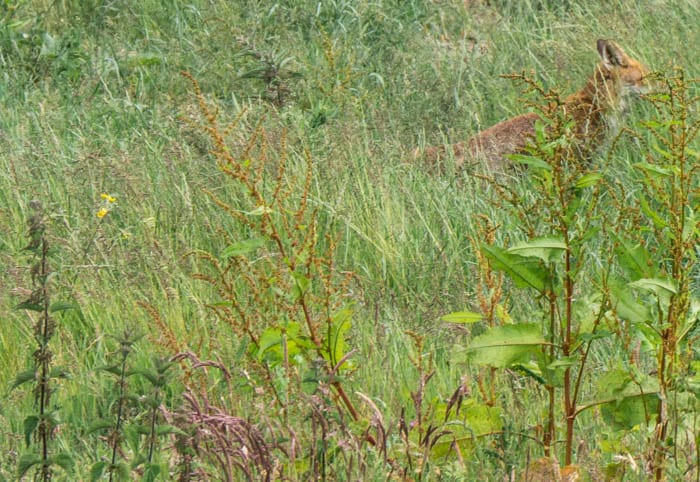 Sometimes at night we hear the cry of the fox, but last week one made its appearance in the broad daylight. First of all I saw something move around in the undergrowth but it was rather camouflaged.
Sometimes at night we hear the cry of the fox, but last week one made its appearance in the broad daylight. First of all I saw something move around in the undergrowth but it was rather camouflaged.
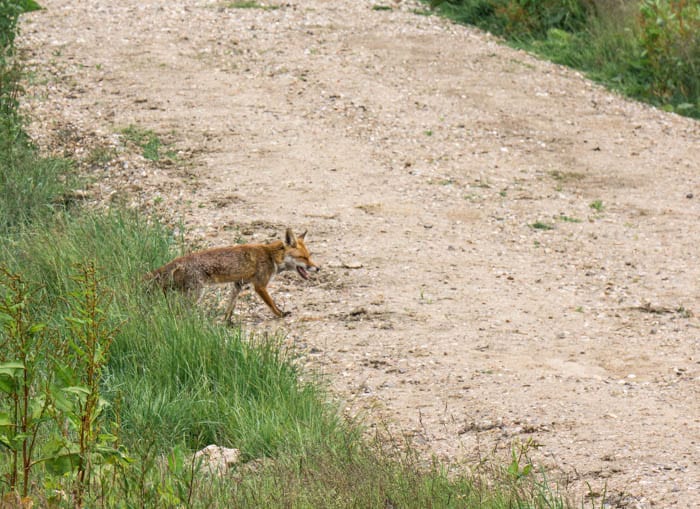 Then out came the red fox and walked up a dirt lane near our garden. My daughter was home with a minor sick bug so I quickly fetched her. She could have one of our wildlife spotter adventures just by standing on our deck and watching the fox in the lane and field below!
Then out came the red fox and walked up a dirt lane near our garden. My daughter was home with a minor sick bug so I quickly fetched her. She could have one of our wildlife spotter adventures just by standing on our deck and watching the fox in the lane and field below!
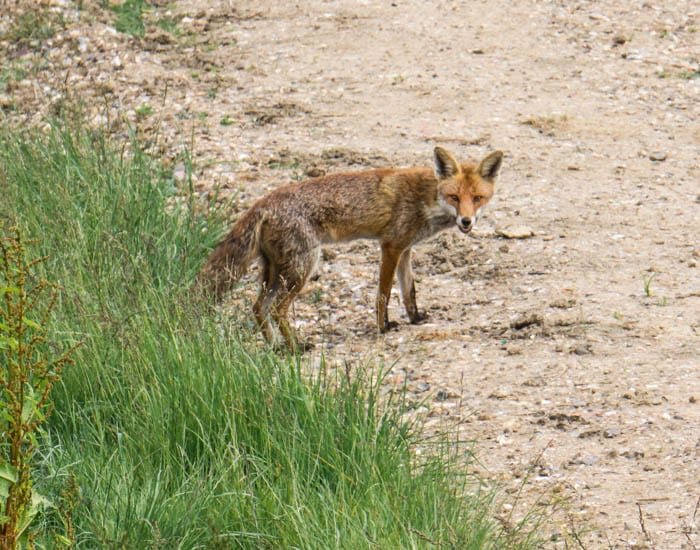
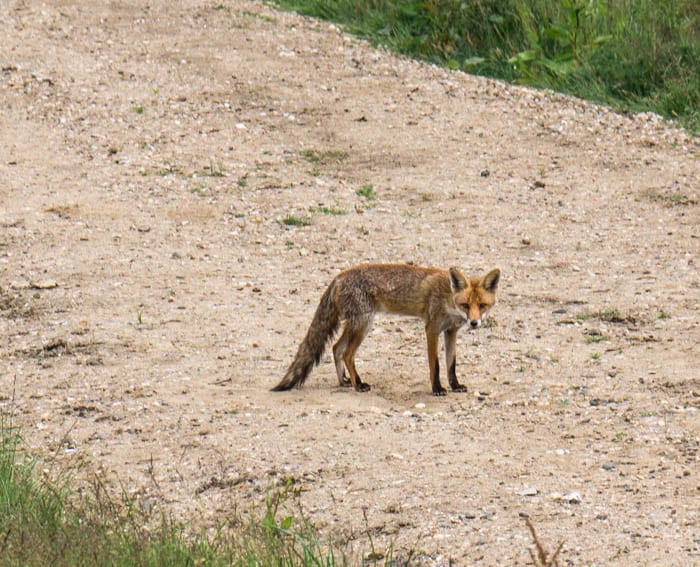
10 Fun Facts about the Red Fox
Whenever I have a wild life spotter adventure with my kids I think it’s important for them to also learn some more about the animal. We found out 10 interesting facts about red foxes:
- Females are called vixen, males are a dog fox or a tod, and their little ones are pups, cubs, or kits. And, if like me, you like knowing the collective nouns for a group, it’s a skulk or leash or troop or lead of foxes.
- The red fox is native to Britain where it now has no natural predators after the disappearance of wolves and bears.
- The life expectancy of a fox in wild is only 2 to 4 years. It has a short life span – less than 2 years in cities and about 3 years in the countryside. They’ve lived much longer in captivity.
- Foxes have great eyesight. Their eyes have vertical splits like a cat.
- Their long bushy tails are known as a ‘brush.’
- The scientific name for a fox is Vulpes vulpes.
- Foxes breed between December and February – when you can often hear the eerie call of the vixen – and so a vixen will have one litter of cubs in the spring.
- Cubs are born completely blind. By the time they are 6 to 10 months old, they strike off on their own.
- The mother and father both take care of the cubs and sometimes an aunt or other foxes will help as well.
- As they have small, slender bodies, foxes can run up to 30 miles (48 kms) an hour.
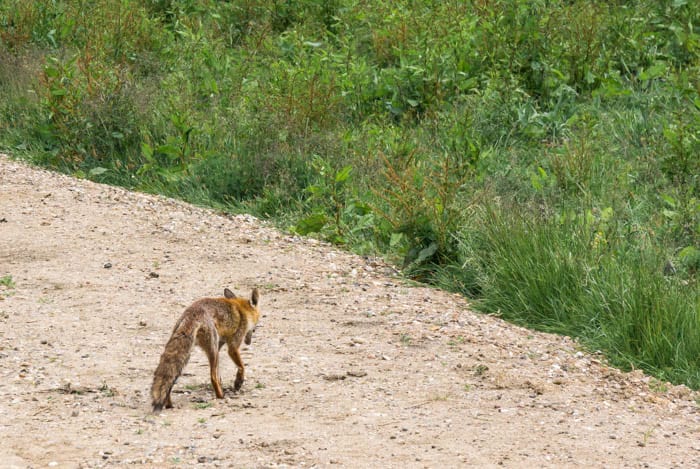 My son, Theo, who is a bit of a fox fan was rather disappointed not to spy on the wild dog. More so, when Luce spotted one run into another field again the next day. I expected them to no longer like these wild animals after a red fox caused havoc at the stables where Luce has riding lessons. Theo’s favourite chicken at the stables and some other feathered friends were eaten or taken away by a fox. As the attack was in the late spring, we assumed the fox was looking for some extra food for a litter of cubs. I was surprised, though, how Luce and Theo accepted that this is the circle of life in rural areas. They also understood why farmers are not happy about foxes near their animals.
My son, Theo, who is a bit of a fox fan was rather disappointed not to spy on the wild dog. More so, when Luce spotted one run into another field again the next day. I expected them to no longer like these wild animals after a red fox caused havoc at the stables where Luce has riding lessons. Theo’s favourite chicken at the stables and some other feathered friends were eaten or taken away by a fox. As the attack was in the late spring, we assumed the fox was looking for some extra food for a litter of cubs. I was surprised, though, how Luce and Theo accepted that this is the circle of life in rural areas. They also understood why farmers are not happy about foxes near their animals.
I often saw foxes roaming the streets when we lived in London. According to research there are way over 30,000 urban foxes who’ve adapted to our cities in Britain.
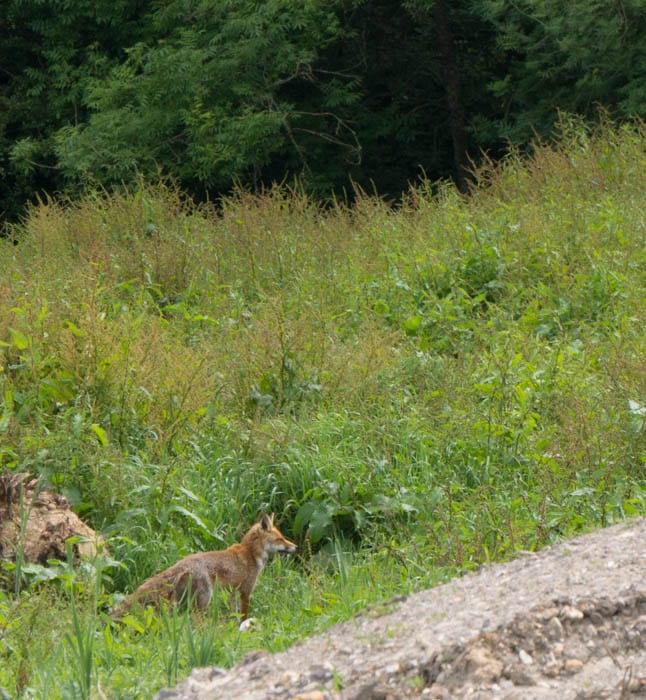 We’ve also observed British carnivores, including the fox, being fed at the British Wildlife Centre in Surrey. But it was rather special to just watch from our home this red fox walk along, stop and gaze, and soon disappear back into the woods right here in the middle of the Sussex countryside.
We’ve also observed British carnivores, including the fox, being fed at the British Wildlife Centre in Surrey. But it was rather special to just watch from our home this red fox walk along, stop and gaze, and soon disappear back into the woods right here in the middle of the Sussex countryside.

That looks like a young fox to me – they are often out and about in daytime once their parents abandon them to fend for themselves. We saw one up the road just last week so I am making sure I put the birds to bed as soon as it gets to dusk as young foxes will often go after domestic poultry, seeing it as an easy meal.
Many thanks for adding these vulpine facts and pictures to #AnimalTales and sorry I was so late commenting – Life has been mad this week.
Lucas says – I really like Foxes but sadly they also like my neighbours chickens next door and Ash is really isn’t his friend either but I really, really, like them 🙂 #animaltales
I’ve seen foxes in broad daylight as well… can’t believe how brazen they are! I guess they’re looking for extra food for the kits at this time of year. Great photos as always x
I see them here in broad daylight too, I must say I’m less than happy as it means we have to lock our rabbits up indoors before they kill them all.
A skulk seems such an appropriate term for group of foxes. How awesome that you to watch him. I have only seen a fox in captivity before.
Funny thing is I used to see foxes all the time in London but only once in a while here in the countryside!
Great pictures and it was nice to be able to read up on some facts about foxes. I’m an information junkie, so I found it very useful 🙂
I always like the kids to learn some new things about animals and find i’m learning at the same time!
surprised foxes can run that fast, lovely photos and so lucky to get so many
I was surprised too how fast they run – apparently even faster sometimes!